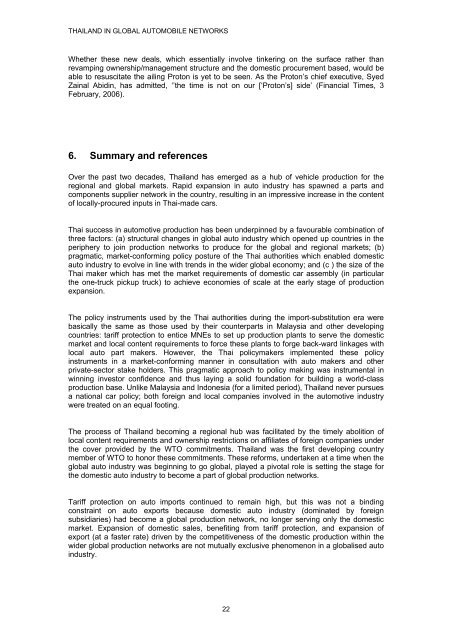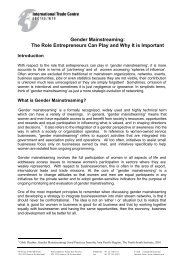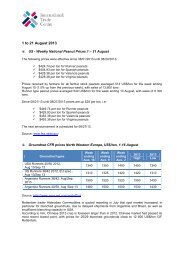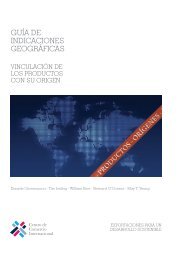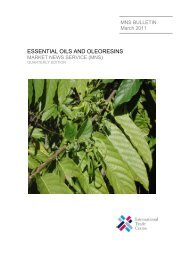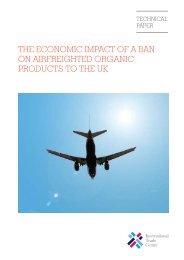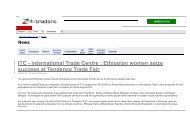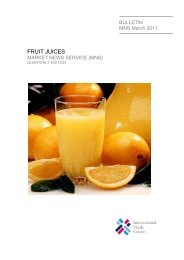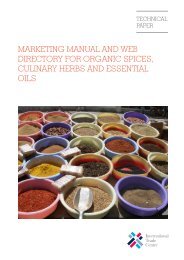thailand in global automobile networks - International Trade Centre
thailand in global automobile networks - International Trade Centre
thailand in global automobile networks - International Trade Centre
You also want an ePaper? Increase the reach of your titles
YUMPU automatically turns print PDFs into web optimized ePapers that Google loves.
THAILAND IN GLOBAL AUTOMOBILE NETWORKS<br />
Whether these new deals, which essentially <strong>in</strong>volve t<strong>in</strong>ker<strong>in</strong>g on the surface rather than<br />
revamp<strong>in</strong>g ownership/management structure and the domestic procurement based, would be<br />
able to resuscitate the ail<strong>in</strong>g Proton is yet to be seen. As the Proton’s chief executive, Syed<br />
Za<strong>in</strong>al Abid<strong>in</strong>, has admitted, ‘’the time is not on our [‘Proton’s] side’ (F<strong>in</strong>ancial Times, 3<br />
February, 2006).<br />
6. Summary and references<br />
Over the past two decades, Thailand has emerged as a hub of vehicle production for the<br />
regional and <strong>global</strong> markets. Rapid expansion <strong>in</strong> auto <strong>in</strong>dustry has spawned a parts and<br />
components supplier network <strong>in</strong> the country, result<strong>in</strong>g <strong>in</strong> an impressive <strong>in</strong>crease <strong>in</strong> the content<br />
of locally-procured <strong>in</strong>puts <strong>in</strong> Thai-made cars.<br />
Thai success <strong>in</strong> automotive production has been underp<strong>in</strong>ned by a favourable comb<strong>in</strong>ation of<br />
three factors: (a) structural changes <strong>in</strong> <strong>global</strong> auto <strong>in</strong>dustry which opened up countries <strong>in</strong> the<br />
periphery to jo<strong>in</strong> production <strong>networks</strong> to produce for the <strong>global</strong> and regional markets; (b)<br />
pragmatic, market-conform<strong>in</strong>g policy posture of the Thai authorities which enabled domestic<br />
auto <strong>in</strong>dustry to evolve <strong>in</strong> l<strong>in</strong>e with trends <strong>in</strong> the wider <strong>global</strong> economy; and (c ) the size of the<br />
Thai maker which has met the market requirements of domestic car assembly (<strong>in</strong> particular<br />
the one-truck pickup truck) to achieve economies of scale at the early stage of production<br />
expansion.<br />
The policy <strong>in</strong>struments used by the Thai authorities dur<strong>in</strong>g the import-substitution era were<br />
basically the same as those used by their counterparts <strong>in</strong> Malaysia and other develop<strong>in</strong>g<br />
countries: tariff protection to entice MNEs to set up production plants to serve the domestic<br />
market and local content requirements to force these plants to forge back-ward l<strong>in</strong>kages with<br />
local auto part makers. However, the Thai policymakers implemented these policy<br />
<strong>in</strong>struments <strong>in</strong> a market-conform<strong>in</strong>g manner <strong>in</strong> consultation with auto makers and other<br />
private-sector stake holders. This pragmatic approach to policy mak<strong>in</strong>g was <strong>in</strong>strumental <strong>in</strong><br />
w<strong>in</strong>n<strong>in</strong>g <strong>in</strong>vestor confidence and thus lay<strong>in</strong>g a solid foundation for build<strong>in</strong>g a world-class<br />
production base. Unlike Malaysia and Indonesia (for a limited period), Thailand never pursues<br />
a national car policy; both foreign and local companies <strong>in</strong>volved <strong>in</strong> the automotive <strong>in</strong>dustry<br />
were treated on an equal foot<strong>in</strong>g.<br />
The process of Thailand becom<strong>in</strong>g a regional hub was facilitated by the timely abolition of<br />
local content requirements and ownership restrictions on affiliates of foreign companies under<br />
the cover provided by the WTO commitments. Thailand was the first develop<strong>in</strong>g country<br />
member of WTO to honor these commitments. These reforms, undertaken at a time when the<br />
<strong>global</strong> auto <strong>in</strong>dustry was beg<strong>in</strong>n<strong>in</strong>g to go <strong>global</strong>, played a pivotal role is sett<strong>in</strong>g the stage for<br />
the domestic auto <strong>in</strong>dustry to become a part of <strong>global</strong> production <strong>networks</strong>.<br />
Tariff protection on auto imports cont<strong>in</strong>ued to rema<strong>in</strong> high, but this was not a b<strong>in</strong>d<strong>in</strong>g<br />
constra<strong>in</strong>t on auto exports because domestic auto <strong>in</strong>dustry (dom<strong>in</strong>ated by foreign<br />
subsidiaries) had become a <strong>global</strong> production network, no longer serv<strong>in</strong>g only the domestic<br />
market. Expansion of domestic sales, benefit<strong>in</strong>g from tariff protection, and expansion of<br />
export (at a faster rate) driven by the competitiveness of the domestic production with<strong>in</strong> the<br />
wider <strong>global</strong> production <strong>networks</strong> are not mutually exclusive phenomenon <strong>in</strong> a <strong>global</strong>ised auto<br />
<strong>in</strong>dustry.<br />
22


